How to Display the File Last Updated Date in Power BI Using Excel VBA or Power Query
In this example, I will demonstrate two methods to display the last updated date for an Excel file in Power BI. Both methods use an Excel file as the data source, although the second method can work with any file type. To clarify, these methods don’t rely on the Power BI timestamp for when the report was published or last refreshed. Instead, they either retrieve the last save time from Excel or use the Date modified timestamp from the file system.
Instructions
Method 1: Excel VBA
The first method uses a custom VBA function in Excel to retrieve the Last Save Time property.
Step 1: Create a User-Defined Function (UDF) to Retrieve Last Save Time
- From the
Developerribbon in Excel, clickVisual Basic. - The
Microsoft Visual Basic for Applicationswindow will open. - From the
Insertmenu, clickModuleto add a new module (namedModule1in this example). - Open
Module1and add the following code to create the custom function that retrieves the last save timestamp:
Option Explicit
Function Last_Saved_Timestamp() As Date
On Error GoTo errorHandler
With Application
.ScreenUpdating = False
.EnableEvents = False
End With
Last_Saved_Timestamp = ThisWorkbook.BuiltinDocumentProperties("Last Save Time")
errorHandler:
With Application
.ScreenUpdating = True
.EnableEvents = True
End With
If Err.Number <> 0 Then
MsgBox Err.Description
End If
End Function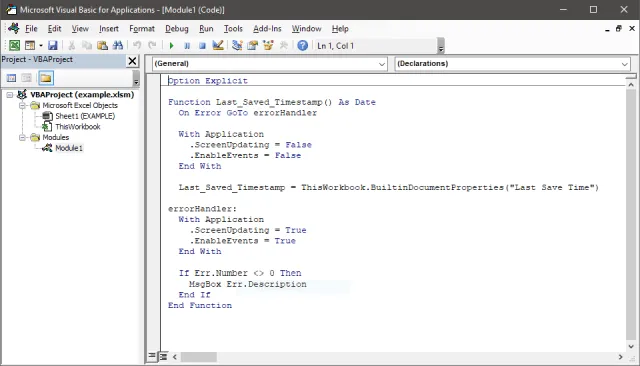
Step 2: Force Full Recalculation Before Save
- From Microsoft Visual Basic for Applications, open
ThisWorkbook. - Add the following code. This code forces a full recalculation of the workbook and updates the timestamp before saving the file.
- Close the
Microsoft Visual Basic for Applicationswindow.
Option Explicit
Private Sub Workbook_BeforeSave(ByVal SaveAsUI As Boolean, Cancel As Boolean)
On Error GoTo errorHandler
With Application
.ScreenUpdating = False
.EnableEvents = False
End With
Application.CalculateFull
errorHandler:
With Application
.ScreenUpdating = True
.EnableEvents = True
End With
If Err.Number <> 0 Then
MsgBox Err.Description
End If
End Sub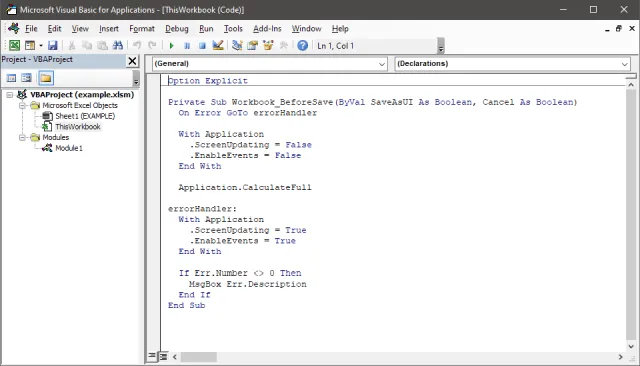
Step 3: Retrieve Last Save Time
- From Excel, create a new worksheet (named
EXAMPLEin this case). - In cell
A1, enterLAST SAVED DATE. - In cell
A2, use the custom VBA function by entering:
=Last_Saved_Timestamp()- The timestamp will appear as a serial number.
- Save and close the Excel file.
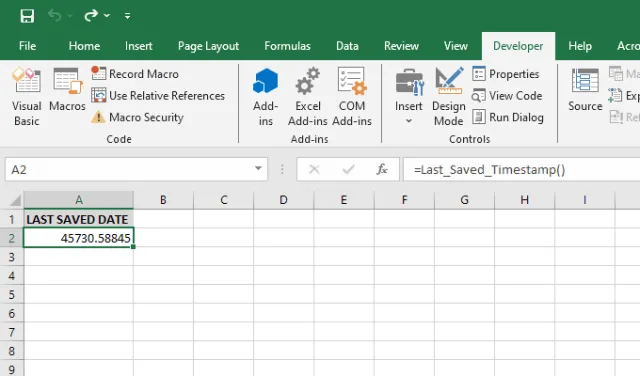
Step 4: Load Data into Power BI
- From the
Homeribbon in Power BI Desktop, clickGet dataand selectExcel workbook. - Select the Excel file you created earlier and click the
Openbutton. - In the
Navigatorwindow, checkEXAMPLEand click theLoadbutton. - The
EXAMPLEtable and theLAST SAVED DATEfield will be available in theDatapane. - If
LAST SAVED DATEis summarized, turn off summarization. In theDatapane, clickLAST SAVED DATE, then from theColumn toolsribbon, selectDon’t summarizefrom theSummarizationdrop-down. - In the
Data typedrop-down, selectDate. If prompted with aData type changewarning, click theYesbutton. - In the
Formatdrop-down, choose your desired date format.

Step 5: Display Data Last Updated Date Using a Card Visualization
- Switch to
Reportview, add aCardvisualization, and dragLAST SAVED DATEfromEXAMPLEinto theFieldssection. - If it defaults to
Earliest, change it toLatest. This step may not be necessary if there’s only one entry in the table, but I recommend changing it toLatestjust in case. - In the
Formatsection, turn off theCategory labeland adjust the font size and other attributes as needed.
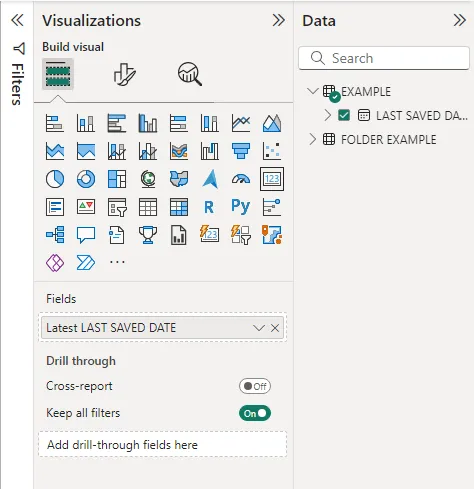
Method 2: Power Query File Properties
The second method uses Power Query to retrieve the Date modified timestamp from the file system properties. This method works with any file type, not just Excel.
Step 1: Get Data
- From the
Homeribbon in Power BI Desktop, clickGet dataand selectMore.... - In the
Get Datadialog box, chooseFileand thenFolder, and click theConnectbutton. - In the
Folderdialog box, enter or browse to the parent folder of the data file. Click theOKbutton. - Another dialog box will appear, listing the files in the selected folder. Click the
Transform Databutton. - The
Power Querywindow will open. The first step in the query is labeledSource, which returns the file list. Verify that the list is correct. - Filter the
Namecolumn so that only the file used by the Power BI report appears. - Select the
Date modifiedcolumn. From theHomeribbon, selectRemove ColumnsandRemove Other Columns. - Rename the
Date modifiedcolumn toLAST SAVED DATEto maintain consistency with the first method. - In the
Query Settingspane underProperties, rename the query to something descriptive, likeFOLDER EXAMPLE. This name will appear in theDatapane in Power BI. - From the
Homeribbon, clickClose & Apply.
Here is the final query code after applying all filters and transformations:
let
Source = Folder.Files(
"C:\test"
),
#"Filtered Rows" = Table.SelectRows(Source, each ([Name] = "example.xlsm")),
#"Removed Other Columns" = Table.SelectColumns(#"Filtered Rows", {"Date modified"}),
#"Renamed Columns" = Table.RenameColumns(
#"Removed Other Columns",
{{"Date modified", "LAST SAVED DATE"}}
)
in
#"Renamed Columns"NOTE: In this demonstration, the file is located at
C:\test\example.xlsm. Adjust the query as necessary.
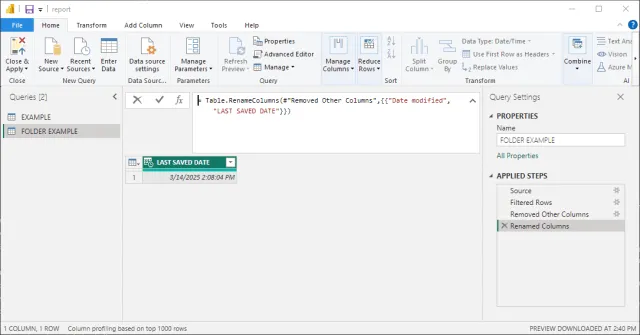
Step 2: Load Data into Power BI
- Returning to Power BI, the
FOLDER EXAMPLEtable and theLAST SAVED DATEfield will be available in theDatapane. - If
LAST SAVED DATEis summarized, turn off summarization. In theDatapane, clickLAST SAVED DATE, then from theColumn toolsribbon, selectDon’t summarizefrom theSummarizationdrop-down. - In the
Data typedrop-down, selectDate. If prompted with aData type changewarning, click theYesbutton. - In the
Formatdrop-down, choose your desired date format.
Step 3: Display Data Last Updated Date Using a Card Visualization
- Switch to
Reportview, add anotherCardvisualization, and dragLAST SAVED DATEfromFOLDER EXAMPLEinto theFieldssection. - If it defaults to
Earliest, change it toLatest. This step may not be necessary if there’s only one entry in the table, but I recommend changing it toLatestjust in case. - In the
Formatsection, turn off theCategory labeland adjust the font size and other attributes as needed.
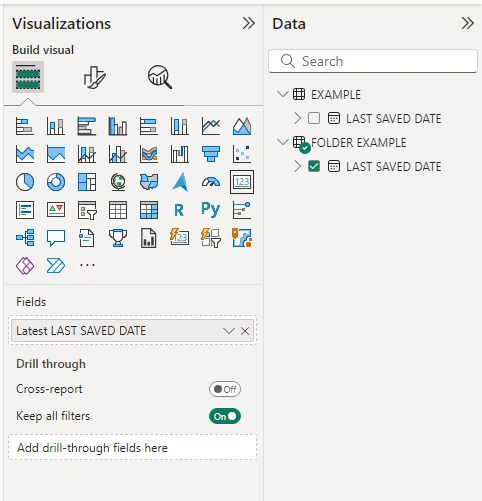
Results
Both methods will produce the same result, as shown in the screenshot below. The report displays the last saved date from either the Excel VBA method or the file system’s Date modified timestamp. When the Power BI report is refreshed, the card visualizations will update with the latest date.

Summary
Both methods allow you to display the last updated date of your data in Power BI, either through Excel VBA or Power Query. The Excel VBA method retrieves the last save time from within Excel, while the Power Query method uses the file system’s Date modified timestamp. Choose the method that best suits your data source and reporting needs.